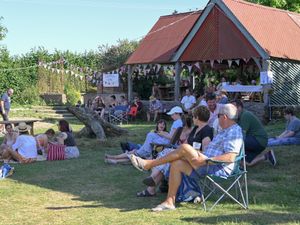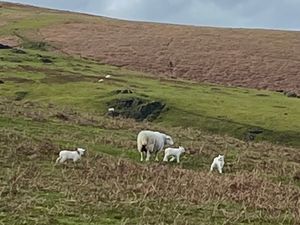Offa's Dyke emerges from the deep at castle
A section of Offa's Dyke, unseen for centuries, has emerged from a lake close to a castle during the dry summer.
The 2018 heatwave has brought up cropmarks and ancient remains seen from the air.
But the lowering of the water levels in rivers and lakes have also seen the uncovering of submerged remains.
While attending an excavation of part of the dyke in the grounds of the National Trust Chirk Castle, archaeologist Professor Howard Williams was astonished to see a hump shaped feature appearing from a lake on adjoining land.
Writing about the experience on the online blog, Archaeodeath, the Professor wrote: "While we were there we got to see over the nearby lake at an eerie site.
"It has long been known that Offa’s Dyke, at one point on the Chirk estate, is submerged beneath a lake created by 18th-century landscaping.
"Indeed, on aerial photographs this section of dyke looks like an uncanny submarinal monster lurking beneath the depths of the lake.
"Thanks to the drought, the leviathan has temporarily risen to the surface and its top is exposed from bank-to-bank across the centre of the lake.
"Access is private, and the lake is framed by trees, but from one tight angle from close to the dig, I got a glimpse of this beast’s huge bulk.
"Ducks, geese and a heron were perched upon it, and after two-and-a-half centuries, it looks like a shingle bank with bushes growing on one section that usually pokes up above the lake.This submarinal dyke will soon be below the water once again and out of sight and mind for most visitors to Chirk."
Professor Williams was visiting the Clwyd-Powys Archaeological Trust’s excavations of an unscheduled section of the dyke to the north of the castle. The dyke is an eighth century earthwork that formed the border of England and Wales.
"Offa’s Dyke has long been known to run through the National Trust-managed grounds of Chirk Castle and in places survives as an impressive monument. Yet in other stretches, it is heavily denuded and poorly understood. "
He said the two bodies had been working together to create new community archaeology excavations at Chirk, including investigating the dyke to better understand its composition and location at points where it has been badly damaged.
"Perhaps these endeavours will one day lead to better public appreciation of the monument at Chirk as a premier tourist attraction in the Anglo-Welsh borderlands."





